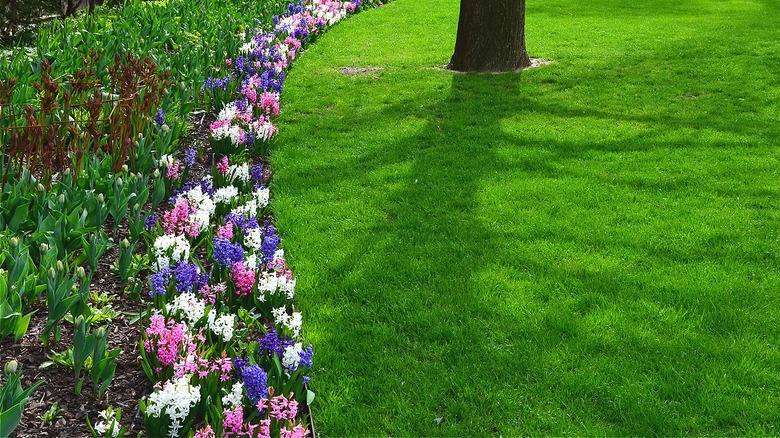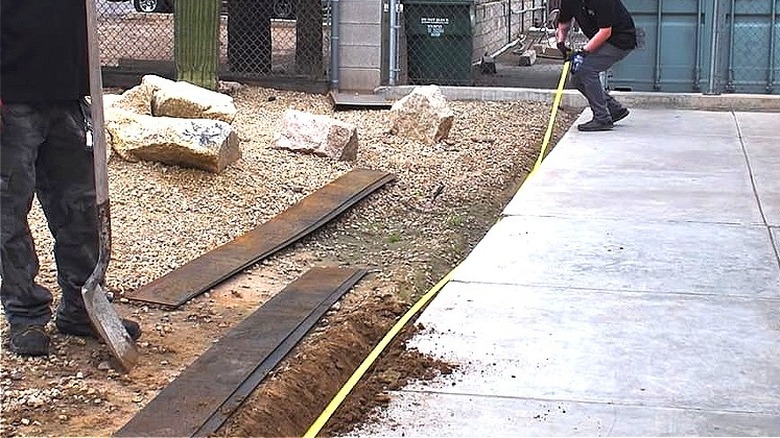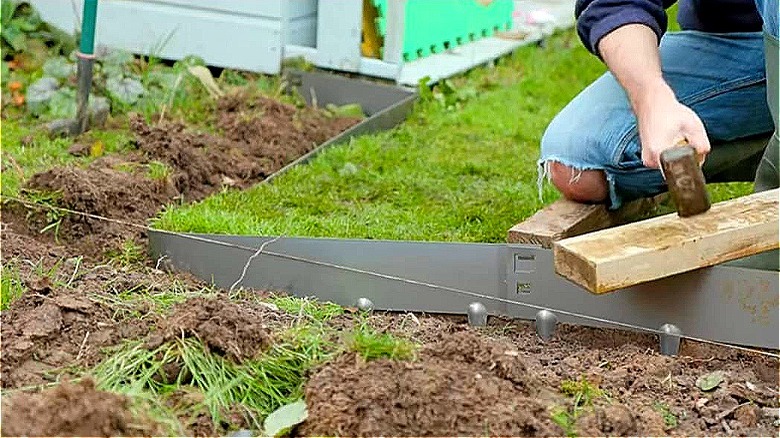Everything To Know About Using Metal Edging In Your Lawn
A well-groomed lawn is like a gourmet pizza — delightful to the senses, but its beauty lies in mastering the intricate recipe. Enter the unsung hero holding this harmony between lawn care ingredients together: metal edging. Picture edging as the lead singer in your lawn care band, providing a neat and visually pleasing barrier between your verdant turf and the other band members, like garden beds, walkways, and driveways. Made of metal, this edging stands firm against harsh weather and the onslaught of garden maintenance tools, refusing to shatter or crumble.
However, every hero has its kryptonite. So, what are the cons of metal edging? The reality check here is that metal edging can be the diva backstage as it's notably costlier than wood and plastic edging. Moreover, the rustic patina that metal assumes over time may not strike the right chords with every homeowner, seeming more like a lead singer's well-worn leather pants than a garden-fashion statement. The primary metal-edging champions are aluminum and steel, each singing a different tune in durability, functionality, and price points. But simply choosing the most suitable material is only half the battle won. To truly harness the power of metal lawn edging, it's crucial to install it the right way.
Types and cost of metal lawn edging
In the vast realm of metal lawn edging, two titans take center stage: steel and aluminum. Their shared metallic ancestry swiftly diverges with their diverse qualities. Steel, a heavyweight champion tipping the scale at an astounding 225 pounds per 100 feet, flaunts its strength effortlessly. Its Herculean endurance fends off bend or break, even when challenged by an errant vehicle, making it a compelling choice for sturdy, functional lawn edging. On the other hand, aluminum edging is light on its feet at a manageable 41 pounds per 100 feet, exuding elegance without strenuous exertion. It's more pliable, thus excelling in crafting intricate, curved designs. And unlike steel, aluminum remains unscathed in its battle against rust. Iron, however, often fades into the shadows (thanks to its heftier weight, rust susceptibility, and reduced flexibility).
The thickness of your chosen lawn edging boils down to your needs. A lighter gauge takes the limelight for aesthetics. However, if focusing more on functionality — like keeping landscaping materials in place — a heavier gauge (meaning a lower gauge number) is your star performer. As for the cost of metal landscape edging, expect somewhere between $2.50 and $6.50 per foot. However, as with any grand production, complexities come at a cost. A winding or curved design means more labor and planning, necessitating a deeper dive into your wallet. The same applies to a tricky terrain, too, complemented by contours, grading requirements, drainage considerations, or the need for retaining walls.
How do you install metal edging on your lawn?
Embark on this thrilling lawn care endeavor by strapping on your gardening gloves and using a tape measure to determine how much edging you'll need for your metal lawn border. Your next exploit is excavating a trench (roughly half as deep as the metal strip's width) along that border. A manual lawn edger like the Ames Steel Landscaping Edger, available at The Home Depot, should do the trick here. Slicing the metal sheets takes a grinder or saw with a metal-cutting blade. Meanwhile, a thin layer of sand at the bottom of the trench boosts the drainage. Progress your mission by inserting the metal edging in the trench, ensuring vertical straightness.
Your rubber mallet steps into the limelight next, driving the stakes into the ground on either side of the metal lawn edging. Remember, too many actors can overcrowd the stage, though, so stick to one stake for roughly every 30 inches of metal sheet. Burying your stakes at a depth of 4 inches guarantees stability. When bridging gaps between strips, position the stake outside the edging to cleverly obscure the union. Finally, refill the trench with soil and make sure no sharp corners are left uncovered.
Feeling a touch or artistic vibe? Paint your new border with a garden-friendly palette. And when the high-stakes drama doesn't quite appeal to you, consider above-ground metal edging. In this subtle performance, only the stakes delve into the ground while the sheets float elegantly.


